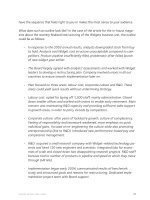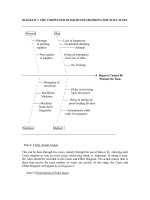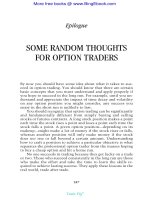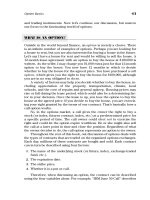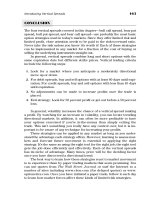The Public Innovator’s Playbook: Nurturing bold ideas in government phần 3 potx
Bạn đang xem bản rút gọn của tài liệu. Xem và tải ngay bản đầy đủ của tài liệu tại đây (445.05 KB, 16 trang )
28
The Public Innovator’s Playbook: Nurturing Bold Ideas in Government
of the organization. Once the word is out,
the innovation will be adopted more easily by
the entire organization and possibly by other
organizations. You can position programs as
successful by sharing the news of employee
appreciation or by highlighting outside awards.
Third-party validation can have a power-
ful impact on the acceptance of new ideas.
For example, many programs that win the
KennedySchool’sInnovationinAmerican
Governmentaward,awardedannuallyto10
projects that set a standard for excellence,
are replicated nationally and internationally.
Organizational silos can be another barrier to
diffusing innovation in public agencies. Govern-
ment employees tend to work within strict
organizational boundaries and make indepen-
dent decisions about which ideas get adopted.
Encouraging employees to work in other or-
ganizations that have implemented innovative
ideas can help them learn how to deploy those
ideas in their own organization. Private sector
organizations that deliver solutions in a variety
of contexts also can serve as agents to diffuse
innovations. They can help ideas traverse
organizational hurdles, and even transfer in-
novative practices from one country to another.
Finally, diffusion of innovation often must
overcome apathy among citizens and political
leaders. Publicizing evidence of success is criti-
cal to building faith among citizens and political
leaders that public money is not being wasted.
The emergence of Web-based social networks
also may help agencies ease the introduction
of innovative processes, particularly when they
require changes in customer behavior. Public
agencies have struggled with marketing these
changes in the past. Many e-governance initia-
tives lacked uptake as citizens continued to
conduct government transactions in person or
via telephone. This meant that some of the sav-
ings expected from online service delivery did
not materialize. In the future, using social net-
works to build support and understanding of
new initiatives may lead to faster acceptance.
“What is now proved,
was once only imagined.”
William Blake
The Public Innovator’s Playbook: Nurturing Bold Ideas in Government
Chapter in a box
Innovation is not just about generating good ideas — that’s only the first step. Organizations also
must select the best ideas, implement them, produce results, and then diffuse them.
Idea generation: Clearly defining the problem and seeking the best possible solution is the first
step in the innovation process. Ideas may be generated internally; agencies also should examine
and perhaps adopt innovations developed in other organizations. One example is the recent “in-
novation exchange” program between the city of London and New York City. London offers its
expertise in dealing with issues like congestion pricing and climate change while New York City
sharesitsexperienceinimprovingaccesstoservicesthrough311andothertechnologyinitiatives.
Selection: Which innovations are worth pursuing? This question is particularly important to public
sector organizations, which have a hard time defending new ideas and face multiple stakehold-
ers who might say no. The World Bank created an innovative process to give good ideas a fair
chance: the Development Marketplace. The Bank set up a “bazaar” in its atrium, with booths
allottedto121teams,eachwithanideatopropose.ApanelofseniorexecutivesfromtheWorld
Bank,privateorganizations,andthenonprotsectorevaluatedtheproposals.Inasingleday,11
ideasreceivedfundingfromatotalbudgetof$3million.
Implementation: Once selected, an idea must be funded, developed, and executed. Incentive
mechanisms such as gainsharing and share-in-savings contracts can help; however, many govern-
ment programs lack predictable end results. Dealing with uncertainties and unexpected events
requiresexibilityandwillingnesstomakemid-coursecorrections.TheFloridaSchoolYear2000
Initiative, a school-reform program that provided teachers handheld devices to record student
information, worked because officials modified the technology used by the program after they
encountered unexpected problems. Successful implementation also requires effective leadership
that defines the mission of the organization and builds a coalition for change.
Diffusion: The last stage in the innovation cycle refers to the spread of an innovation through-
out an organization or from one organization to another. This requires gaining support from all
stakeholders, breaking down organizational silos, and overcoming apathy toward innovations.
One way to encourage diffusion is to “create a buzz” around successful innovations. The Florida
Department of Children and Families, which provides various child and community care services,
slashedcustomerwaittimesby45minutes,reducedturnover,andsaved$11millionannually.
Afterthedepartment’seffortsearnedseveralawards,wordspreadfast,andsoonotherstateand
federal agencies copied its efforts.
The
innovation
cycle
29
The ve innovation
strategies
T
here is no established theoretical framework for cultivating innova-
tion — no immutable laws that, when applied, will start good ideas roll-
ing off an assembly line. But successful organizations create an atmosphere
that welcomes suggestions — and adopts them when appropriate.
Forinstance,SouthwestAirlinesemployeesspent10hoursaweekforsix
months brainstorming changes in the company’s aircraft operations. Those
meetings, which included members of the airline’s in-flight, ground, main-
tenance,anddispatchoperations,generated109ideasforhigh-impact
changes.Acriticalpartofthisprocesswastappingintothediverse,even
if imperfect, knowledge base of each employee. One director from the
schedule-planning division successfully challenged assumptions held by the
maintenanceanddispatchpersonnelfor30years.
14
Three ideas developed
through these meetings triggered extensive operational adjustments, one of
which allowed Southwest to reduce the number of aircraft “swaps” when
mechanical failures require one aircraft to be substituted for another.
In the public sector, relatively few organizations encourage change. Instead,
stories of successful government innovations often profile determined individu-
als overcoming formidable odds. Rigid rules and processes, often developed to
control corruption and nepotism, constrain innovation. Evidence collected by the
NAOreportcitedearlieristelling:governmentorganizationstendto“accumu-
late innovations.” They generally know what needs to change, but they wait
for alterations in “ministerial or policy priorities” or efficiency drives before they
implementthosechanges.Mostinnovations(around50percent)aretriggered
byseniorandmiddlemanagers,followedbyministers(around20percent).
33
Cultivate
Cultivate
2
Cultivate
Internal
orientation
External
orientation
Replicate Partner Network
Open
source
▼
▼
Primary source
of innovation:
employees
34
The Public Innovator’s Playbook: Nurturing Bold Ideas in Government
Frontline employees tend to play a very small
partininnovations(around8percent),ac-
cording to the report.
15
They often do not
know what constitutes a good suggestion,
let alone how to lead an initiative to improve
performance. This picture is in sharp contrast
to most innovative private sector organiza-
tions, which have eschewed hierarchy and
created formal structures designed to capture
information and feedback from employees.
But it is possible to cultivate an environ-
ment in public agencies that more consis-
tently sparks moments of creativity — the
brilliant idea, the novel principle, the solu-
tion to a long-standing problem, or the
argument that finally debunks old prejudices
anddogmas.Here’show(gure2.1):
Tap into the diverse tacit knowledge
in the field
Tacit knowledge which exists within the
minds of employees, is born of sheer experi-
ence. It is the know-how gained by prac-
tice and deliberate study, the wisdom and
judgment derived from daily exposure to
an environment over time. It is the kind of
knowledgethatmakesa30-yeargovern-
ment employee an expert at navigating
Byzantine public sector personnel rules.
Tacit knowledge can generate innova-
tion. But how do you capture that knowl-
edge and convert it into practices that
not only help organizations perform bet-
ter but also deliver more valuable service?
Develop
emerging ideas
through safe
havens
Tap into tacit
knowledge
Drive
organizational
change
Enablers
Create safe havens
Employ prediction
markets
Use tools for
collaboration
Motivators
Establish two-way
communication
Give ownership of ideas
Align incentives
Accept failures
Figure 2.1: Cultivate strategy: benefits and approaches
Engaged
employees
Engaged
employees
Engaged
employees
The Public Innovator’s Playbook: Nurturing Bold Ideas in Government
This question has attracted the attention
of the best minds in the business world.
Companies now promote cross-functional
excellence, an approach that requires tap-
ping into the divergent perspectives of
employees from different functions and
disciplines to challenge established mind-sets,
open up the organization to new think-
ing, and generate high-impact solutions.
Frontline employees often know more about
customer needs and have better ideas about
how to improve performance than their bosses.
However, they often need help understanding
the needs of the entire organization, explain-
ing how their ideas address those needs, and
determining how to implement change.
Engage employees at all levels
Three questions need to be an-
swered when considering how to en-
gage employees to innovate.
How do employees know what a good
suggestion is? Tesco, the largest supermarket
chain in the United Kingdom, has defined the
criteria in simple terms: better for customers,
simpler for staff, and cheaper for Tesco. Man-
agement communicates these principles to all
employees.Eachyear,thetop2,000executives
spend a week on the shop floor at the check-
out counter or in a warehouse stacking shelves.
They get feedback from colleagues and cus-
tomers, collate all the information, and send it
to the relevant division heads.
16
The program,
called Tesco Week in Store Together (TWIST), is
making a real difference in serving customers
better by bringing the senior management and
store-levelemployeestogether.AccordingtoSir
Terry Leahy, Tesco’s chief executive, “TWIST will
mean that every senior manager has worked
for a week in store, served our customers,
and listened to what they and their colleagues
have to say. That is experience you can’t get
in a training room or on a quick store visit.”
17
Who decides which ideas are worth
following up, and who takes charge of
implementing changes? The In-House R&D
Network at the Bureau of Motor Equipment
of the New York City Department of Sanita-
tion allows worksite committees of mechanics
to adopt proposals and implement changes
within the scope of their operations, with the
agreement of the facility manager. Bureau
analysts help work out the business case for
each project. If the proposal demands greater
resources than the operation can provide, or if
it requires coordination with other government
agencies, the bureau’s leaders are enlisted.
For even bigger projects, the bureau seeks
approval through the city’s budget process.
18
Anumberofinnovationsbytheworkershave
been patented, such as a device that shuts
down the engine to protect it from burnout
when the oil in a truck drops too low.
19
Are frontline employees ready to create
the required change? When the U.S. Depart-
ment of the Interior began a new approach to
land management known as “cooperative con-
servation,” it engaged its frontline employees
in establishing partnerships to create holistic
solutions by combining local understanding
with scientific knowledge. For example, to
prevent the endangered short-tailed alba-
35
Cultivate
36
The Public Innovator’s Playbook: Nurturing Bold Ideas in Government
trosses from getting caught on the fishermen’s
hooksinthewatersoffAlaska,localgroups
in partnership with scientists came up with
several solutions: one of them was to weight
the fishing lines to sink the hooks below the
surface, where they wouldn’t snag the birds.
Thedepartment’s4CsTeam,whichwas
formed to identify barriers to and best practices
for the new initiative, realized that implement-
ing cooperative conservation required not only
technical skills but also managerial capabilities.
It further concluded that teams composed of
people from diverse professional backgrounds
and with varied competencies tend to out-
perform teams of “experts” who all have the
same knowledge and skill sets. For example,
the program needed people who could create
a work environment that encourages creative
thinking, who could persuade others and build
consensus, and who would keep up-to-date
on key national and international trends. To
find such people, the department changed
its hiring criteria. It also redesigned its train-
ing programs to create the new competen-
cies. To strike a balance between flexibility
and accountability, it is currently analyzing
exactly how employees can be creative and
still meet certain basic policy objectives.
Employ prediction markets
Prediction markets work like stock markets:
people make bets on the likely outcome. For ex-
ample, in the Hollywood Stock Exchange, people
use play money to bet on which films will win
Oscars in the top eight categories, or how much
a film will make in sales.
20
Research shows that prediction market fore-
casts routinely outperform opinion polls or
expert opinions. That has been the case, for
example, with Iowa Electronic Market, which
uses real money to predict election results in
the United States and elsewhere.
21
Private
firms are developing innovative ways to use
this principle, creating prediction markets
where employees can bet on future events,
such as sales forecasts and project end date.
Organizations use this kind of independent
mechanism to aggregate diverse insights from
their employees. They can then construct a real-
istic picture of their own operation. For example,
Eli Lilly has created an internal market that allows
employees to predict which drugs will make it
through to the next phase of clinical trials. This
gives the company leadership a good sense of
which products to put its resources behind.
22
Siemens allows employees to bet on projects
they think will finish on time, which helps direct
managerial attention to critical projects. Hewlett
Packard employs the same mechanism to predict
monthly sales of printers more accurately than
the marketing team does with its own processes.
Prediction markets could be employed in the
public sector to track a number of variables,
such as inflation, unemployment, and the likely
impact of changes in interest rates on economic
activity. Or they could be used internally to
identify projects likely to overshoot time and
cost estimates. However, to do so, govern-
ments will have to liberalize gambling laws that
currently restrict the use of prediction markets.
Governments are not likely to find the predic-
tion market tool useful for internal projects.
The Public Innovator’s Playbook: Nurturing Bold Ideas in Government
Use tools for collaboration
Web2.0ischangingthewaygovernments
do their business. It makes collaboration
possible in innovative ways through blogs,
wikis, tags, and peer-to-peer networking.
Blogs or web logs let people share informa-
tion and knowledge and allow informal net-
works to operate within an organization. These
are “online diaries” of posts and comments
that establish a channel of communication
and promote free discussion of issues within
the organization. Blogs can be updated easily
at virtually no cost. They also give manage-
ment an effective way to convey information
to employees, answer questions, build logs
of projects, and provide other updates.
Wikis are used to organize and update blogs,
buttheirusesextendbeyondthat.Awikiisan
online tool that allows users to create and edit
pages of information, with the changes appear-
ing on the site almost as soon as contributors
make them. To control abuse, some systems
require users to authenticate their identities
beforemakingchanges.Anexampleofthe
use of a wiki in government is Intellipedia,
developedbytheCIA,whichletsemployees
across a number of security agencies engage in
open discussions on topics of concern to them.
Typically, a wiki has no structured hierarchy,
whether in regard to the names on an organi-
zational chart or the way information might be
structured within the site, and no formal con-
trol systems for organizing or editing content.
These are considered to be the main advan-
tages of a wiki: they give it speed and flexibility.
In addition to wikis, organizations may
also use peer-to-peer networking sites (which
allow users to share files and data through
high-speed connections) for real time col-
laboration. One of the best-known examples
of this technology is the music-sharing service
Napster, which music publishers sued suc-
cessfully for copyright infringement.
The U.S. military is experimenting with
peer-to-peer networking to allow troops
on the ground to interact and collaborate
instantaneously, without being bogged down
by organizational and technical protocols and
hierarchies.
23
During operations in both Kosovo
andAfghanistan,disparatecomputersystems
blocked effective communication between the
Army,Navy,andAirForce.Peer-to-peersystems
can ease communication among soldiers on
the ground and between U.S. troops and al-
lied troops, bypassing the obstacles raised by
incompatible systems or security protocols.
The most important contribution these col-
laboration tools make is that they “separate
the idea of chain of command from chain of
information,” according to James Cartwright,
vice chairman of the Joint Chiefs of Staff.
24
Tap informal networks
Recent research shows that informal chan-
nels are more efficient conduits for information
and ideas than formal channels defined by the
organizational structure. The methodology and
process of social network analysis is a good ex-
ample of a new means of igniting organization-
allearning.AsnotedbyexpertsDr.RobCross
of the University of Virginia and Valdis Krebs,
management consultant, social network analy-
37
Cultivate
38
The Public Innovator’s Playbook: Nurturing Bold Ideas in Government
sis of an organization or community’s informal
networks can provide new insights for leaders
trying to understand how organizations work.
Dr. Cross has argued that social net-
work analysis can be a valuable analytical
tool for exposing and analyzing networks
that exist within an agency or community.
Social network analysis can help to an-
swer important questions, including:
• Howdoesinformationow
across networks?
• Arecertainpeopleoverlycentralto
managing work and information flows?
• Aresomepeoplelooselycon-
nected and underused?
• Aretheredivisivesubgroups?
• Isthenetwork’slevelofcon-
nection sufficient?
Consider the need for interagency coopera-
tion for national security. The ability to create
and maintain a personal network is crucial
to enhancing collaboration and transcend-
ing the bureaucracy that has historically
blockedinterorganizationalcooperation.As
such, security agencies could greatly enhance
their self-awareness, and fill an important
information gap, by using social network
analysis to increase their understanding
of actual processes and workflows.
Dr. Cross’s social network analysis tool also
reveals the most important players in an agency
or communities’ informal networks, including
those who facilitate and impede collabora-
tion. This kind of analysis has the potential
to be a baseline study from which to assess
progress on collaboration. It also could fill a key
knowledge gap by giving an accurate portrayal
of the agency’s current level of connectivity and
integration. Finally, the analysis can identify key
niche experts who have abilities that may be
very specific to certain areas of the network.
Productive peripheral positions can be created
for these individuals, along with individualized
career paths that fit their specialized skill set.
Tapping into the wisdom of employees
requires new mechanisms that separate
responsibility and performance from job
title and position in the hierarchy. However,
organizations need to supplement these ef-
forts with incentive mechanisms that nurture
change by breaking the perception that
innovations are high-risk, low-gain affairs.
Drive organizational change
Creating an innovative organization does
not always require large-scale changes that
turn the organization upside down. Some-
times it merely requires figuring out the levers
for change. Like the trim tab that turns the
rudder, changing the direction of a huge
ship, these levers of an organization facili-
tate change without a major upheaval.
Small changes can sometimes create big
results. Using blogs and wikis, creating predic-
tion markets, and allowing employees to
implement their own ideas: these are small
changes to create big results. It does not
stop there, however. Creating an innovative
organization requires addressing issues that
influence behavior. For instance, when em-
ployees are asked to share their views openly,
The Public Innovator’s Playbook: Nurturing Bold Ideas in Government
are managers ready to get honest feedback
that shows what is wrong? Or will they get
embroiled in a blame game, trying to corner
the employee into thinking that she is wrong?
Take a “systems” view
For a ship to turn left, its rudder has to turn
right. For the rudder to turn right, the trim tab
(like a tiny rudder, which helps turn the rudder
around.)
25
hastogoleft.Acaptainknowing
the way the whole system works together
preventstheshipfromgoingoff-course.A
systemic view allows an understanding of
the interrelationship between key variables
and how changing a variable affects the
entire system. Human systems are, of course,
infinitely more complex than rudders.
26
Systems influence behavior. If you create
a system where employees generate a lot of
good ideas but fail to put in place measures
to acknowledge and implement these ideas,
it will ultimately create a negative response
that brings the entire system back into bal-
ance. In this case, the idea generation process
will slow to a crawl. The harder you push
the system to generate ideas, the greater the
resistance because more good ideas accumu-
late and employees get the signal that their
ideasarenotbeingheard.Addressingthis
systemic problem requires building credibility
by tracking the conversion rate of good ideas
into meaningful innovations and converting
more and more good ideas into practice.
Align incentives
Governments need to provide incentives for
risk taking and create mechanisms for calculat-
ing risk, so that the fear of failure does not
trumpthedesiretocreatenewinitiatives.Any
innovation carries risks; in general, the bigger
the change, the higher the risk (see inset on
“Types of Risk”). Public scrutiny and media cyni-
cism make it dangerous for public employees to
launch any sort of new initiative except the kind
thatisvirtuallyguaranteedtosucceed.Afterall,
no public manager wants to drink her morn-
ing glass of orange juice reading a headline in
12-pointtypedescribingherlatestscrew-up.
27
Many governments provide financial
rewards (bonuses and performance pay) and
offer awards and recognition to innovators.
28
Gainsharing, or sharing the financial benefits of
performance improvement and cost reduc-
tion with employees, is one example of this.
The U.S. federal government has developed
rules and programs meant to recognize the
value of contributions that employees make
to the government. However, “those of us
with government experience,” notes Patrick J.
Keogh, “know that award programs tend to
be reactive rather than proactive.”
29
Keogh,
aonetimeemployeeatVicePresidentAl
Gore’s National Performance Review, cites an
interesting personal example to show that
these programs are not as well publicized or
utilized as they should be. While working at the
GeneralServicesAdministration(GSA),Keogh
was approached by an investment banker with
a proposal that would save the government
$25million.Keoghrealizedthathewouldneed
the support of six or seven key people within
the government for the initiative to succeed.
39
Cultivate
40
The Public Innovator’s Playbook: Nurturing Bold Ideas in Government
TSA’sideafactory
InApril2007,theU.S.TransportationSecurityAdministration(TSA)launchedasecureintranet
Web site called the “Idea Factory” that allows employees to submit ideas for improving agency
operationsandprocesses.BytheendofJanuary2009,employeeshadsubmitted7,837ideas
and69,712comments.Ofthoseideas,about39havebeenimplementedbytheTSA.
TheTSAcreatedtheIdeaFactorysiteafteraninternalsurveyrevealedthatTSAemployeesbe-
lievedtheirvoiceswerenotbeingheardbytheagency’sleadership.TSAemployeesnowreview
ideas posted on the site, and they vote for the suggestions they think are most worthy of man-
agement attention. The best ideas receive a certificate and a memento from the organization.
ResponsetotheTSA’sIdeaFactoryhassparkedwidespreadinterestintheideaasameth-
od for breaking through organizational barriers to innovation. The site is an extremely good
example of how to create a positive environment for innovative ideas.
The guiding principle for any initiative to generate innovations is to understand that ulti-
matelyyouwillgetonlyasmanyideasasyouhavetheabilitytoimplement.Apurelylinearview
of the Idea Factory process would suggest that because employees submitted so many good
ideas, they translated into multiple initiatives. However, a systems view would suggest that so
many good ideas were submitted because these ideas were acknowledged and implemented,
creating a positive environment for submitting more ideas.
The Public Innovator’s Playbook: Nurturing Bold Ideas in Government
Researching the Code of Federal Regulations
andGSA’sinternalorders,hefoundaprovision
buried in the personnel policy that allowed
cash awards to employees who created sav-
ings. He decided that he could share the award
with his colleagues as an incentive for pushing
aheadwiththeproject.“Ayearlater,thedeal
was done and we requested our spiff,” Keogh
says.“ItwassplitbetweenveGSAemploy-
ees and two at the treasury department.”
30
Keogh points out that many government
agencies have the same kinds of award and
bonus programs found in the private sector.
Managers do not use them widely, however,
and employees often have no idea how they
are likely to be measured and rewarded if they
make suggestions that improve operations.
Proactive award programs empower em-
ployees to pursue rewards, rather than leaving
managers to dispense them as an afterthought
forajobwelldone.Aligningincentivesalso
means that when employees perform in ways
that merit awards, their annual reviews note
that performance. Cultural change is not likely
to happen if employees who “risk” innova-
tion see no positive impact on their careers.
Some organizations also provide innova-
tive employees with grants they can use
in any way to promote further innovation,
perhaps hiring staff or procuring new tech-
nology. In government, this tactic sometimes
takes the form of a productivity bank, a pot
of money that funds good ideas offered by
employees, thus encouraging employees to
suggest new ideas and receive funding.
Accept failures
Innovation is about experimentation. Experi-
mentsoftenfail.Acan’t-afford-to-failenviron-
ment is not very conducive to making ambi-
tious decisions or investments. It also seldom
results in a high-performance organization.
41
Cultivate
Types of risk
• Organizational: Costs of introducing change
could turn out to be higher than the benefits.
• Political: Politicians and senior officials do
not want to be seen backing the wrong horse
— or a losing one.
• Personal: Failure could damage the career
of the person introducing the change. Success,
on the other hand, may do little to advance
career growth.
• Counter-reinvention: The value of an inno-
vation can be offset by new rules and regula-
tions. For example, the death knell for factory
assembly of complete homes was sounded
by new building regulations (tougher zoning
and land-use ordinances, wheelchair access
for multifamily homes, and prohibition of lead
paint) that made this kind of new housing pro-
hibitively expensive.
42
The Public Innovator’s Playbook: Nurturing Bold Ideas in Government
Successful innovations tend to be unpredict-
able. Innovative companies often build failure
into their systems of innovation. The idea is
to fail quickly if you have to, learn from the
experience, and move on to the next big idea.
AtIDEO,thedesigncompanythatdesigned
Apple’srstmouseandthesleekpalm-held
device called Palm V, the culture invites em-
ployees to “have the guts to create a straw
man” that others can criticize, so that they can
“fail often to succeed sooner.”
31
3M,which
manufactures adhesives, oral care products,
and software for supply chain management,
among other things, brings together “skunk
works” teams (discussed in the next section) to
investigate the problems in a potential product.
Acceptingfailureshasthepotentialto
keep good money from following bad
money. If employees know that they can
stop a project that has failed or is likely to
fail without damaging their careers, they are
more likely to shut it down before it blows
up into a big-ticket failure.
32
The option to
do so is better than persisting with a project
to the end, wasting time, money, and ef-
fort.Acceptingfailurealsosendsthesignalto
employees that innovation is important and
that failure will not result in a blame game.
Develop and nurture emerging ideas
Bureaucratic structures developed to enforce
compliance with rules and procedures can
kill budding ideas because innovations often
require challenging the status quo or ques-
tioning long-held assumptions that may have
worked well in the past. Without loosening the
sometimes suffocating grip of bureaucracy over
the more creative employees, it will be difficult
to motivate them to innovate. This means dis-
mantling or bypassing structures and systems
that ensure conformity and stifle creativity, and
building new structures that encourage fresh
thinking. One such structure is the safe haven.
Safe havens — separate units kept close to
mainstream activities but away from line orga-
nizations — permit low-risk experimentation.
For example, New York’s Center for Technology
in Government (CTG) lets state and local agen-
cies experiment with computer-based processes
before making big investments.
33
The state’s
Office of Children and Family Services recently
collaborated with CTG on a pilot to evaluate
whether portable IT platforms, such as wire-
less laptops, could improve child protective
service investigations while reducing costs.
The pilot ran in two counties, Westchester
and Monroe, and a detailed assessment
was made based on surveys, interviews, and
analysis of data from the central case man-
agement database. The results showed that
mobile devices improved performance. But the
analysis also revealed a number of qualifiers,
such as the need to account for individual work
preferences and organizational support. The
focus now is on conducting a second phase
of larger-scale trials before full deployment.
34
Conducting pilots like these in a safe haven
gives employees time to develop emerging
ideas and protects them from short-term
budget constraints and premature criticism.
While safe havens work as enablers in the
The Public Innovator’s Playbook: Nurturing Bold Ideas in Government
public sector, they can also work as motivators
for “renegade” thinkers — not people seek-
ing to undermine authority, but independent
visionaries looking to achieve results. Not con-
tent merely to acquiesce and conform, these
talented individuals can find working in small
teams with little bureaucracy and paperwork
an exhilarating and rewarding experience.
Skunk works
Atypeofsafehaven,skunkworksare
composed of a small group of highly talented
and motivated people who are freed from
bureaucracy, paper work, and most rou-
tine administrative responsibilities. The term
originatedin1943attheLockheedAircraft
Corporation, where a small group that went
bythatnamedeliveredtheprototypeXP-80
ghterplanein143days,sevendaysahead
of schedule. Skunk works have the poten-
tial to deliver results in governments as well.
Some of the best examples of skunk works
in the public sector are the ones formed
to attack the most complex problems.
The Manhattan Project, the program to
develop the nuclear bomb during World War
II, can be considered a scaled-up version of
a skunk works project. Relocated to New
Mexico with their families, some of the fin-
est scientific minds of that time put together
the formulas for refining uranium and cre-
ated a working atom bomb within six years,
well ahead of their German counterparts.
The Technology Strategy Board within the
UK Department for Business Enterprise and
Regulatory Reform is a more recent example
ofskunkworksinthepublicsector.Asmall
group of people from diverse backgrounds
(business, government, and academia) is
charged with translating knowledge into in-
novation, setting priorities for research and
funding, and developing the government’s
strategy for establishing the United Kingdom
as a global leader in innovation and technol-
ogy. For example, it has set up the Low Impact
Buildings Innovation Platform that will bring
together key players from industry, academia,
and government to reduce carbon emissions
from buildings. (Forty-five percent of the
total carbon emission in the United Kingdom
comes from buildings.) Efforts directed at
meetingthetargetofa60percentreduction
incarbonemissionby2050willlikelyprove
futile unless there is dramatic improvement in
the design, construction, and management of
buildings. The initiative will commission stud-
ies, set up demonstrator projects to validate
solutions, and explore new business models,
among other things, with financial support
from the board and other funding agencies.
Intrapreneurs
TheAmericanHeritageDictionarydenes
an intrapreneur as “a person within a large
corporation who takes direct responsibility for
turning an idea into a profitable finished prod-
uct through assertive risk-taking and innova-
tion.” Gifford Pinchot, an author and consultant
on innovation management, introduced the
conceptinhis1985book,Intrapreneuring. His
goal: to show how large organizations can fos-
ter innovations.
35
The idea is gaining currency
43
Cultivate


